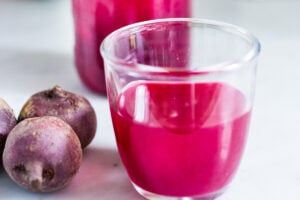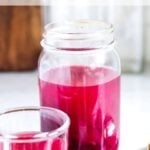Description
How to Make Beet Kvass! An Eastern European probiotic drink made with beets, sea salt and water. Full of healthy probiotics from the Lacto-fermentation, Beet Kvass is believed to help boost immunity. It tastes slightly sweet, tangy, earthy and salty- but in a good way! With just 10 minutes of hands-on time,it is so simple- just let mother nature take its course. (Allow 2 weeks for fermentation- see notes for speeding up this process.)
Ingredients
- 2 medium beets, organic (see notes for doubling, recommended) 2 cups diced, skin ON.
- 3 cups filtered water (tap water may have too much chlorine & inhibit fermentation)
- 1 heaping tablespoon fine sea salt
- 1/4 cup fermented pickle brine or fermented kraut brine, or 1-2 tablespoons whey (liquid from strained yogurt)
- fresh dill (or fennel fronds), bay leaves, or other herbs.
- pickling spices ( fennel seed, coriander seed, dill seed, peppercorns, celery seeds, caraway, etc.) Tip: to prevent them from floating, either add them to the jar first, place beets over the top, or place a small mesh bag. Remove any that float to the surface.
- sliced onion or shallots
- fresh garlic cloves
- fresh sliced ginger or turmeric root.
Instructions
- Prep: Rinse and slice the beets into ¼-inch thick rounds, then dice them, leaving the skin on. You want that bacteria from the skin, so don’t peel! Get a clean, 1-quart mason jar.
- Assemble: If adding any whole spices, add these to the jar first, then add garlic, onion or dill if using. Add all the beets overtop. If adding whey, kraut brine or pickle brine, add this now.
- Make the brine: Mix 3 cups water with 1 heaping tablespoon sea salt. Pour this into the jar, leaving an inch of headroom at the top. If you need more brine: the ratio is 1 heaping teaspoon of salt, per 1 cup of water. Mix it first, then add. The salt will kill the harmful bacteria, but allow the healthy lactobacilli to flourish.
- Remove any spices or seeds that float to the top. Anything that touches the surface can mold. I check daily for floaters! Cover with a loose-fitting lid. Place in a bowl or baking dish (to collect any overflow- a sign of fermentation!).
- Ferment: Place the jar in a cool, dark place 60F-65 F is ideal. Check every couple days, removing seeds if need be. If you added whey or brine, you should see some action within 5-7 days. If not, it can take up to 2 weeks before you notice some slight bubbling when you tap the jar, indicating that it is fermenting. The longer it ferments, the more tangy it will taste, so you can ferment “to taste.” For an even tangier flavor, continue fermenting for 1-2 more weeks. Once happy with the flavor, refrigerate.
- Refrigerate (either strain, or leave beets in- I leave mine in). It will continue to ferment in the fridge, but at a much slower rate, developing more depth of flavor. The sugar from the beets will continue to feed the healthy bacteria.
- If you notice any white foam on top of your kvass it is most likely kahm yeast and harmless. Skim it off with a spoon and toss. If you see mold, I would discard the batch.
- Store this in the fridge, strain into a cup, and drink a few ounces daily. Yes, you can eat the beets!
Notes
This will last indefinitely in the fridge. I highly recommend making a double batch of this because of the longer fermentation time.
Flavor this up!!! I love adding onion, garlic and pickling whole spices. You can get small mesh cotton bags to put your spices in if you like, then no worries about “floaters.”
You can speed up fermentation significantly by adding a few tablespoons of whey ( liquid from strained yogurt) ¼ cup of fermented pickle brine or fermented kraut brine (make sure it is alive and bubbly- from the refrigerated section of the grocery store, not pickled with vinegar) to the jar.
Fermentation slows down in cooler places and speeds up in warmer places.
Nutrition
- Serving Size: ½ cup
- Calories: 20
- Sugar: 3.1 g
- Sodium: 1202.8 mg
- Fat: 0.1 g
- Saturated Fat: 0 g
- Carbohydrates: 4.3 g
- Fiber: 1.3 g
- Protein: 0.7 g
- Cholesterol: 0 mg

